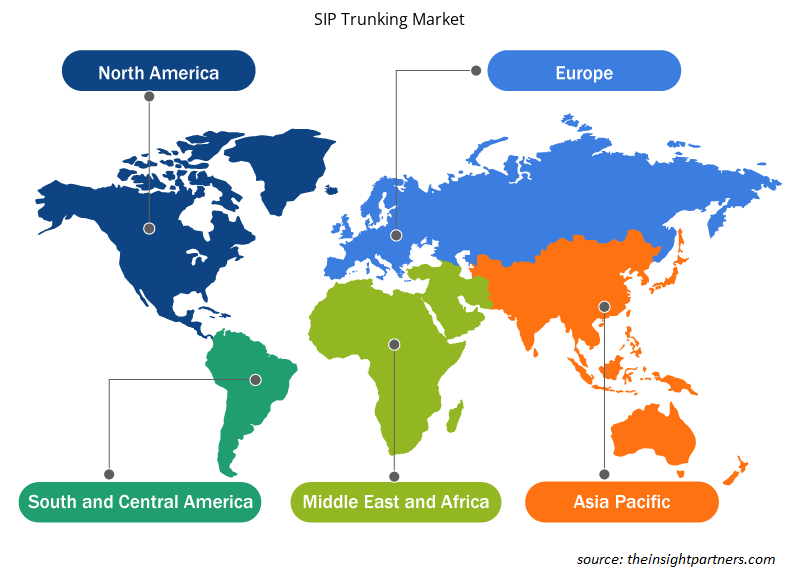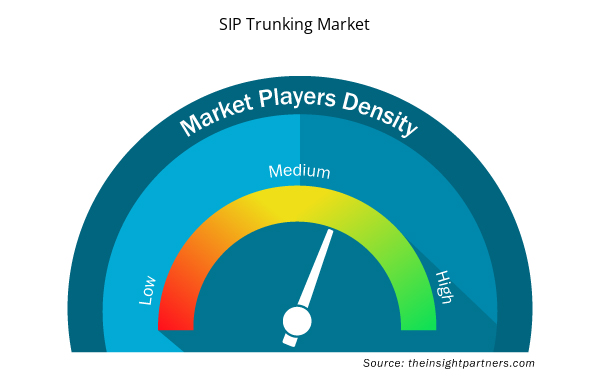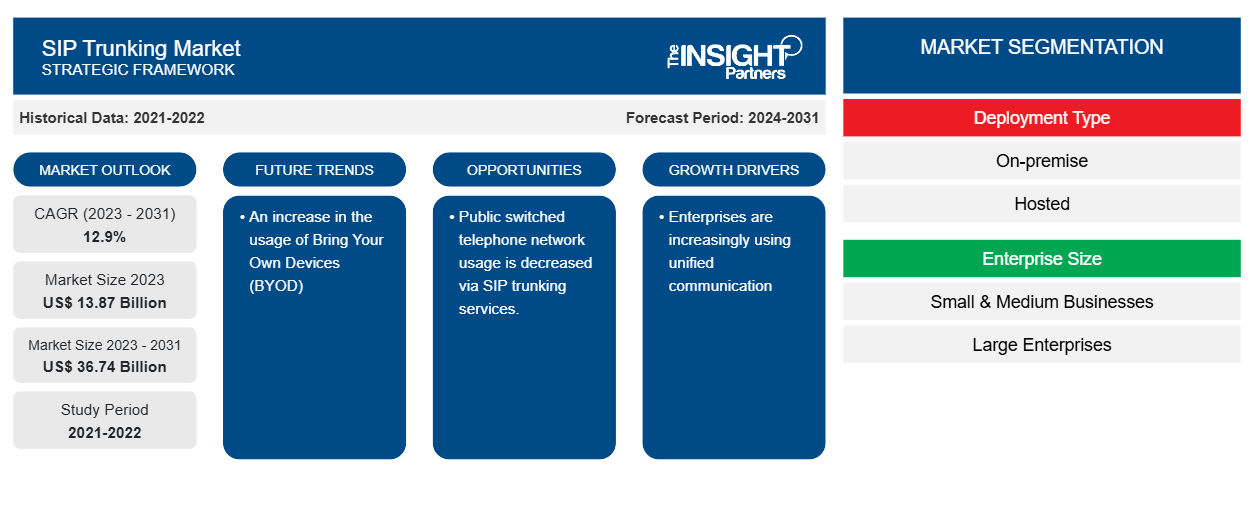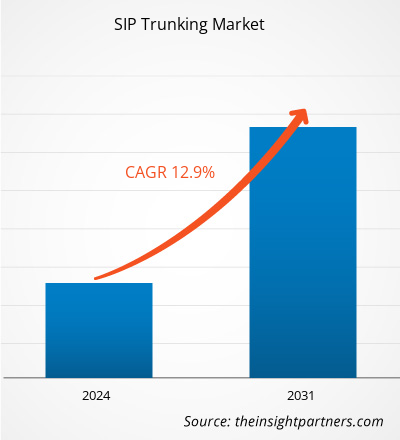Der SIP-Trunking-Markt soll von 13,87 Milliarden US-Dollar im Jahr 2023 auf 36,74 Milliarden US-Dollar im Jahr 2031 anwachsen. Der Markt soll in den Jahren 2023–2031 eine durchschnittliche jährliche Wachstumsrate (CAGR) von 12,9 % verzeichnen. Die weltweit zunehmende Nutzung von Bring Your Own Devices (BYOD) dürfte ein wichtiger Trend im SIP-Trunking-Markt bleiben.
SIP-Trunking-Marktanalyse
Der Bedarf an SIP-Trunking wird durch die zunehmende Nutzung von Unified Communications (UC)-Lösungen in Unternehmenskontexten, einen deutlichen Rückgang der Telefonkosten und einen schnellen Return on Investment (ROI) durch die Trunking-Dienste vorangetrieben. Die Nachfrage nach SIP-Trunking-Diensten stieg, weil Unternehmen dadurch keine zusätzlichen Gateways für das öffentliche Telefonnetz (PSTN) mehr kaufen mussten. Die Nachfrage nach SIP-Trunking wird durch die Notwendigkeit getrieben, die Servicezuverlässigkeit durch das Hinzufügen von VoIP-Diensten und die Bereitstellung verschiedener digitaler Streaming-Funktionen zu erhöhen. Dennoch behindern wachsende Sicherheitsbedenken der Endbenutzer die Expansion des SIP-Trunking-Geschäfts. Andererseits wird erwartet, dass die zunehmende Nutzung von SIP-Trunking in vertikalen Branchen, einschließlich Gesundheitswesen, Gastgewerbe und Restaurants, eine Reihe von Möglichkeiten für das Wachstum des SIP-Trunking-Marktes bietet.
SIP-Trunking-Marktübersicht
Der als „SIP-Trunking“ bezeichnete Dienst eines Kommunikationsdienstleisters verwendet das Session Initiation Protocol (SIP), um Voice-over-IP-Zugriff (VoIP) zwischen einem öffentlichen Telefonnetz (PSTN) und einem Telefonsystem vor Ort bereitzustellen. Der SIP-Trunking-Dienst wird für den Aufbau, die Verwaltung und den Abbau von Anrufen verwendet. Gehostete und vor Ort installierte SIP-Trunking-Dienste sind die beiden Hauptkategorien. Mit einer gehosteten Nebenstellenanlage (PBX) können Benutzer PBX-Funktionen wie Voicemail, Anrufweiterleitung, automatische Vermittlung und automatische Anrufverteilung nutzen, ohne die gesamte erforderliche Hardware vor Ort verwalten oder besitzen zu müssen.
Passen Sie diesen Bericht Ihren Anforderungen an
Sie erhalten kostenlos individuelle Anpassungen an jedem Bericht, einschließlich Teilen dieses Berichts oder einer Analyse auf Länderebene, eines Excel-Datenpakets sowie tolle Angebote und Rabatte für Start-ups und Universitäten.
- Holen Sie sich die wichtigsten Markttrends aus diesem Bericht.Dieses KOSTENLOSE Beispiel umfasst eine Datenanalyse von Markttrends bis hin zu Schätzungen und Prognosen.
Treiber und Chancen auf dem SIP-Trunking-Markt
Unternehmen nutzen zunehmend Unified Communication.
Der Internet Telephony Service Provider (ITSP) bietet einen Dienst namens SIP-Trunk an, der die Kommunikation zwischen dem ITSP und der Private Branch Exchange (PBX) des Unternehmens erleichtert. SIP-Trunk ermöglicht es Unternehmen, über ein IP-Netzwerk wie das Internet eine Verbindung zum öffentlichen Telefonnetz (PSTN) anzubieten, im Gegensatz zu herkömmlichen Telefondiensten, bei denen ein Dienstanbieter Bündel physischer Kabel an ein Unternehmen liefert. Dies motiviert Unternehmen, Unified Communication (UC)-Lösungen zu implementieren, um mit Hilfe des SIP-Trunkings Telefonkosten zu sparen und den Return on Investment zu erhöhen. Der globale Markt für SIP-Trunking wächst aufgrund dieses Faktors.
Die Nutzung des öffentlichen Telefonnetzes wird durch SIP-Trunking-Dienste verringert.
Da SIP-Trunking-Service-Edge-Geräte pro Leitung oft günstiger sind als das gleiche herkömmliche PSTN-Gateway-System, bietet die Installation eines solchen Geräts im Kommunikationsnetzwerk eines Unternehmens eine kostengünstigere Möglichkeit, neue Leitungen hinzuzufügen. Der Markt für SIP-Trunking-Dienste optimiert die Bandbreitennutzung erheblich und erhöht die Netzwerkeffizienz, indem sowohl Sprache als auch Daten über dieselbe Verbindung übertragen werden. Der Markt für SIP-Trunking-Dienste wird durch die Möglichkeit eines Unternehmens angetrieben, mit dem SIP-Trunking-Dienst internationale Anrufe zum Preis eines Ortsgesprächs zu tätigen. Daher wird die Nutzung öffentlicher Telefonnetze durch SIP-Trunking verringert und es wird erwartet, dass dies den Akteuren auf dem SIP-Trunking-Markt im Prognosezeitraum neue Möglichkeiten bietet.
Segmentierungsanalyse des SIP-Trunking-Marktberichts
Wichtige Segmente, die zur Ableitung der SIP-Trunking-Marktanalyse beigetragen haben, sind Bereitstellungstyp, Unternehmensgröße und Endbenutzer.
- Basierend auf dem Bereitstellungstyp ist der SIP-Trunking-Markt in On-Premises und Cloud unterteilt. Das Cloud-Segment hatte im Jahr 2023 einen größeren Marktanteil.
- Nach Unternehmensgröße ist der Markt in kleine und mittlere Unternehmen sowie große Unternehmen segmentiert.
- Basierend auf den Endbenutzern ist der SIP-Trunking-Markt in die Bereiche Bildung, IT und Telekommunikation, Einzelhandel, Medien und Unterhaltung, BFSI, Gesundheitswesen und Regierung segmentiert.
SIP-Trunking-Marktanteilsanalyse nach geografischer Lage
Der geografische Umfang des SIP-Trunking-Marktberichts ist hauptsächlich in fünf Regionen unterteilt: Nordamerika, Asien-Pazifik, Europa, Naher Osten und Afrika sowie Südamerika/Süd- und Mittelamerika. In Bezug auf den Umsatz hatte Nordamerika den größten Anteil am SIP-Trunking-Markt. Diese unerforschten Märkte bieten SIP-Dienstanbietern enorme Möglichkeiten. SIP-Trunking-Dienste werden von Großhandelsanbietern und Unternehmen an diesen Standorten als zuverlässiger und kostengünstiger Ersatz für herkömmliche Telefonsysteme übernommen, um unabhängig von der geografischen Lage eine zuverlässige Konnektivität innerhalb von Organisationen zu erreichen.
Regionale Einblicke in den SIP-Trunking-Markt
Die regionalen Trends und Faktoren, die den SIP-Trunking-Markt im Prognosezeitraum beeinflussen, wurden von den Analysten von Insight Partners ausführlich erläutert. In diesem Abschnitt werden auch die SIP-Trunking-Marktsegmente und die Geografie in Nordamerika, Europa, im asiatisch-pazifischen Raum, im Nahen Osten und Afrika sowie in Süd- und Mittelamerika erörtert.

- Erhalten Sie regionale Daten zum SIP-Trunking-Markt
Umfang des SIP-Trunking-Marktberichts
| Berichtsattribut | Details |
|---|---|
| Marktgröße im Jahr 2023 | 13,87 Milliarden US-Dollar |
| Marktgröße bis 2031 | 36,74 Milliarden US-Dollar |
| Globale CAGR (2023 - 2031) | 12,9 % |
| Historische Daten | 2021-2022 |
| Prognosezeitraum | 2024–2031 |
| Abgedeckte Segmente | Nach Bereitstellungstyp
|
| Abgedeckte Regionen und Länder | Nordamerika
|
| Marktführer und wichtige Unternehmensprofile |
|
Marktteilnehmerdichte: Der Einfluss auf die Geschäftsdynamik
Der SIP-Trunking-Markt wächst rasant, angetrieben durch die steigende Nachfrage der Endnutzer aufgrund von Faktoren wie sich entwickelnden Verbraucherpräferenzen, technologischen Fortschritten und einem größeren Bewusstsein für die Vorteile des Produkts. Mit steigender Nachfrage erweitern Unternehmen ihr Angebot, entwickeln Innovationen, um die Bedürfnisse der Verbraucher zu erfüllen, und nutzen neue Trends, was das Marktwachstum weiter ankurbelt.
Die Marktteilnehmerdichte bezieht sich auf die Verteilung von Firmen oder Unternehmen, die in einem bestimmten Markt oder einer bestimmten Branche tätig sind. Sie gibt an, wie viele Wettbewerber (Marktteilnehmer) in einem bestimmten Marktraum im Verhältnis zu seiner Größe oder seinem gesamten Marktwert präsent sind.
Die wichtigsten auf dem SIP-Trunking-Markt tätigen Unternehmen sind:
- CenturyLink
- AT&T
- Bandbreite
- Mitel
- Net2Phone
- GTT Communications
Haftungsausschluss : Die oben aufgeführten Unternehmen sind nicht in einer bestimmten Reihenfolge aufgeführt.

- Überblick über die wichtigsten Akteure auf dem SIP-Trunking-Markt
Neuigkeiten und aktuelle Entwicklungen zum SIP-Trunking-Markt
Der SIP-Trunking-Markt wird durch die Erfassung qualitativer und quantitativer Daten nach Primär- und Sekundärforschung bewertet, die wichtige Unternehmensveröffentlichungen, Verbandsdaten und Datenbanken umfasst. Im Folgenden finden Sie eine Liste der Entwicklungen auf dem Markt für Sprach- und Sprechstörungen und Strategien:
- Im August 2021 unterzeichnete 8x8, Inc. einen neuen Vertriebsvertrag mit SYNNEX Corporation, um der Partnergemeinschaft von SYNNEX, bestehend aus traditionellen Value-Added Resellern (VARs), Systemintegratoren und Managed Service Providern (MSPs), Zugriff auf 8x8 XCaaS zu gewähren.
(Quelle: 8x8, Inc., Pressemitteilung)
Abdeckung und Ergebnisse des SIP-Trunking-Marktberichts
Der Bericht „SIP-Trunking-Marktgröße und -prognose (2021–2031)“ bietet eine detaillierte Analyse des Marktes, die die folgenden Bereiche abdeckt:
- Marktgröße und Prognose auf globaler, regionaler und Länderebene für alle wichtigen Marktsegmente, die im Rahmen des Projekts abgedeckt sind
- Marktdynamik wie Treiber, Beschränkungen und wichtige Chancen
- Wichtige Zukunftstrends
- Detaillierte PEST/Porters Five Forces- und SWOT-Analyse
- Globale und regionale Marktanalyse mit wichtigen Markttrends, wichtigen Akteuren, Vorschriften und aktuellen Marktentwicklungen
- Branchenlandschaft und Wettbewerbsanalyse, einschließlich Marktkonzentration, Heatmap-Analyse, prominenten Akteuren und aktuellen Entwicklungen
- Detaillierte Firmenprofile
- Historische Analyse (2 Jahre), Basisjahr, Prognose (7 Jahre) mit CAGR
- PEST- und SWOT-Analyse
- Marktgröße Wert/Volumen – Global, Regional, Land
- Branche und Wettbewerbsumfeld
- Excel-Datensatz


- Smart Locks Market
- Water Pipeline Leak Detection System Market
- Green Hydrogen Market
- Lymphedema Treatment Market
- Single-Use Negative Pressure Wound Therapy Devices Market
- Educational Furniture Market
- Online Recruitment Market
- Fill Finish Manufacturing Market
- Frozen Potato Market
- Pipe Relining Market

Report Coverage
Revenue forecast, Company Analysis, Industry landscape, Growth factors, and Trends

Segment Covered
This text is related
to segments covered.

Regional Scope
North America, Europe, Asia Pacific, Middle East & Africa, South & Central America

Country Scope
This text is related
to country scope.
Häufig gestellte Fragen
The global SIP trunking market was estimated to be US$ 13.87 billion in 2023 and is expected to grow at a CAGR of 12.9% during the forecast period 2023 - 2031.
Enterprises are increasingly using unified communication, and public switched telephone network usage is decreased via SIP trunking services are the major factors that propel the global SIP trunking market.
The increase in usage of Bring Your Own Devices (BYOD) globally is anticipated to play a significant role in the global SIP trunking market in the coming years.
The key players holding majority shares in the global SIP trunking market are CenturyLink, AT&T, Bandwidth, Mitel, and Net2Phone.
The global SIP trunking market is expected to reach US$ 36.74 billion by 2031.
Trends and growth analysis reports related to Technology, Media and Telecommunications : READ MORE..
The Insight Partners performs research in 4 major stages: Data Collection & Secondary Research, Primary Research, Data Analysis and Data Triangulation & Final Review.
- Data Collection and Secondary Research:
As a market research and consulting firm operating from a decade, we have published and advised several client across the globe. First step for any study will start with an assessment of currently available data and insights from existing reports. Further, historical and current market information is collected from Investor Presentations, Annual Reports, SEC Filings, etc., and other information related to company’s performance and market positioning are gathered from Paid Databases (Factiva, Hoovers, and Reuters) and various other publications available in public domain.
Several associations trade associates, technical forums, institutes, societies and organization are accessed to gain technical as well as market related insights through their publications such as research papers, blogs and press releases related to the studies are referred to get cues about the market. Further, white papers, journals, magazines, and other news articles published in last 3 years are scrutinized and analyzed to understand the current market trends.
- Primary Research:
The primarily interview analysis comprise of data obtained from industry participants interview and answers to survey questions gathered by in-house primary team.
For primary research, interviews are conducted with industry experts/CEOs/Marketing Managers/VPs/Subject Matter Experts from both demand and supply side to get a 360-degree view of the market. The primary team conducts several interviews based on the complexity of the markets to understand the various market trends and dynamics which makes research more credible and precise.
A typical research interview fulfils the following functions:
- Provides first-hand information on the market size, market trends, growth trends, competitive landscape, and outlook
- Validates and strengthens in-house secondary research findings
- Develops the analysis team’s expertise and market understanding
Primary research involves email interactions and telephone interviews for each market, category, segment, and sub-segment across geographies. The participants who typically take part in such a process include, but are not limited to:
- Industry participants: VPs, business development managers, market intelligence managers and national sales managers
- Outside experts: Valuation experts, research analysts and key opinion leaders specializing in the electronics and semiconductor industry.
Below is the breakup of our primary respondents by company, designation, and region:

Once we receive the confirmation from primary research sources or primary respondents, we finalize the base year market estimation and forecast the data as per the macroeconomic and microeconomic factors assessed during data collection.
- Data Analysis:
Once data is validated through both secondary as well as primary respondents, we finalize the market estimations by hypothesis formulation and factor analysis at regional and country level.
- Macro-Economic Factor Analysis:
We analyse macroeconomic indicators such the gross domestic product (GDP), increase in the demand for goods and services across industries, technological advancement, regional economic growth, governmental policies, the influence of COVID-19, PEST analysis, and other aspects. This analysis aids in setting benchmarks for various nations/regions and approximating market splits. Additionally, the general trend of the aforementioned components aid in determining the market's development possibilities.
- Country Level Data:
Various factors that are especially aligned to the country are taken into account to determine the market size for a certain area and country, including the presence of vendors, such as headquarters and offices, the country's GDP, demand patterns, and industry growth. To comprehend the market dynamics for the nation, a number of growth variables, inhibitors, application areas, and current market trends are researched. The aforementioned elements aid in determining the country's overall market's growth potential.
- Company Profile:
The “Table of Contents” is formulated by listing and analyzing more than 25 - 30 companies operating in the market ecosystem across geographies. However, we profile only 10 companies as a standard practice in our syndicate reports. These 10 companies comprise leading, emerging, and regional players. Nonetheless, our analysis is not restricted to the 10 listed companies, we also analyze other companies present in the market to develop a holistic view and understand the prevailing trends. The “Company Profiles” section in the report covers key facts, business description, products & services, financial information, SWOT analysis, and key developments. The financial information presented is extracted from the annual reports and official documents of the publicly listed companies. Upon collecting the information for the sections of respective companies, we verify them via various primary sources and then compile the data in respective company profiles. The company level information helps us in deriving the base number as well as in forecasting the market size.
- Developing Base Number:
Aggregation of sales statistics (2020-2022) and macro-economic factor, and other secondary and primary research insights are utilized to arrive at base number and related market shares for 2022. The data gaps are identified in this step and relevant market data is analyzed, collected from paid primary interviews or databases. On finalizing the base year market size, forecasts are developed on the basis of macro-economic, industry and market growth factors and company level analysis.
- Data Triangulation and Final Review:
The market findings and base year market size calculations are validated from supply as well as demand side. Demand side validations are based on macro-economic factor analysis and benchmarks for respective regions and countries. In case of supply side validations, revenues of major companies are estimated (in case not available) based on industry benchmark, approximate number of employees, product portfolio, and primary interviews revenues are gathered. Further revenue from target product/service segment is assessed to avoid overshooting of market statistics. In case of heavy deviations between supply and demand side values, all thes steps are repeated to achieve synchronization.
We follow an iterative model, wherein we share our research findings with Subject Matter Experts (SME’s) and Key Opinion Leaders (KOLs) until consensus view of the market is not formulated – this model negates any drastic deviation in the opinions of experts. Only validated and universally acceptable research findings are quoted in our reports.
We have important check points that we use to validate our research findings – which we call – data triangulation, where we validate the information, we generate from secondary sources with primary interviews and then we re-validate with our internal data bases and Subject matter experts. This comprehensive model enables us to deliver high quality, reliable data in shortest possible time.


 Holen Sie sich ein kostenloses Muster für diesen Bericht
Holen Sie sich ein kostenloses Muster für diesen Bericht